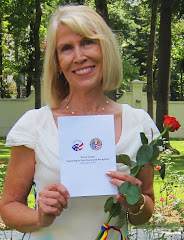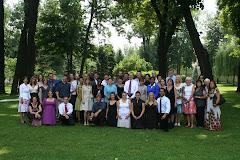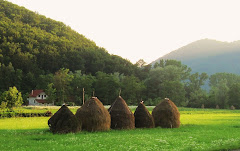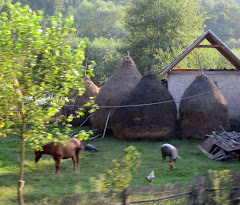 A young Romanian woman on the train back from Moldavia asked Connie and me if we liked Romania, and before we could answer, she shook her head and said "Disappointing, isn't it?" We had just spent six days seeing the glorious painted monasteries of Moldavia and the old medieval capital town of Suceava, a fine symphony concert and botanic gardens of Iasi. We both leaped to disagree and thought it sad that so many Romanians only see the country's problems and not the riches all around them. But WE certainly enjoyed them, taking our spring holiday on the other side of the country in an ancient area we have wanted to see. Getting there was adventure enough--a long train ride from Oradea to Suceava where we stayed for 3 days and then a bus ride to Iasi for a few more days, and finally a 12-hour train ride back to Oradea. When I bemoaned the fact that we were only going about 350 miles (albeit, over mountains some of the way), Connie pointed out the bright side: slow trains mean photo opportunities. So we lowered the window of our compartment or walked into the hall and lowered one on the other side and took boo-coos of shots. The spring weather was wonderful and we saw the awakening fields and fruit trees, the grazing sheep and horses, and industrious farmers and villagers scroll by.****Being in Suceava this time of year was especially fun because it is the home of the famous Easter eggs of Bocavina. At a craft fair in the town square, earnest vendors sold fine traditional pottery, linens, carved spoons, clothing, and eggs, eggs, eggs! These intricately decorated beauties were being sold for only 5 to 7 lei (about $1.65--$2.30) each. I wanted to buy them all! I settled for 15--all different with symbolic traditional markings. Of further interest in the town was a well-preserved-and-maintained village museum where we saw traditional dances along with authentic buildings and tools from the eighteenth and nineteenth centuries. And then we had to see the medieval fortress, lovingly restored in places, presiding majestically over the city, just as Steven the Great (Stefan Cel Mare who fought off the Turkish invaders) would have wanted.**** The next day we and our interesting fellow hostel guests (a Japanese fellow living in Spain, an Indonesian teacher living in France, a Canadian, two Americans and one Romanian) set out for the tour of the painted monasteries. We only had time for the four most impressive ones, which was enough to absorb, I can tell you. What makes these 15th and 16th century churches so special is that the colors of the frescoes on the exteriors of the buildings have remained vivid and stunning all these centuries. The explanation has to do with the composition of the dyes, of course--all from minerals. The sun doesn't bleach out rocks, so the south sides of the churches are still rich and bright. Driving winds and rain, however, erode the dyes, so the north side paintings are all but washed away. The much-beloved bright blue of the Veronet church, for instance, is made of ground lapis lazuli. The paintings, depicting Bible stories but also the fall of Constantinople, the ancient Greek philosophers, a lengthy poem, and local saints and heroes were intended to educate and instruct the illiterate of the day. Could the artists have possibly guessed how long people would be standing and staring at their artwork?****Our stay in Iasi, a city of 338,000 near the border of the Republic of Moldova, was brief, but we got to attend the symphony (Handel's Messiah)and see the country's oldest public university, a few impressive churches, and many monuments honoring their favorite son, the nationally beloved poet Mihai Emanescu. We also spent a splendid afternoon in the botanic garden and the adjoining beer garden. ;-) All in all, the Romania we encountered in this spring-time get-away did not disappoint in the least!
A young Romanian woman on the train back from Moldavia asked Connie and me if we liked Romania, and before we could answer, she shook her head and said "Disappointing, isn't it?" We had just spent six days seeing the glorious painted monasteries of Moldavia and the old medieval capital town of Suceava, a fine symphony concert and botanic gardens of Iasi. We both leaped to disagree and thought it sad that so many Romanians only see the country's problems and not the riches all around them. But WE certainly enjoyed them, taking our spring holiday on the other side of the country in an ancient area we have wanted to see. Getting there was adventure enough--a long train ride from Oradea to Suceava where we stayed for 3 days and then a bus ride to Iasi for a few more days, and finally a 12-hour train ride back to Oradea. When I bemoaned the fact that we were only going about 350 miles (albeit, over mountains some of the way), Connie pointed out the bright side: slow trains mean photo opportunities. So we lowered the window of our compartment or walked into the hall and lowered one on the other side and took boo-coos of shots. The spring weather was wonderful and we saw the awakening fields and fruit trees, the grazing sheep and horses, and industrious farmers and villagers scroll by.****Being in Suceava this time of year was especially fun because it is the home of the famous Easter eggs of Bocavina. At a craft fair in the town square, earnest vendors sold fine traditional pottery, linens, carved spoons, clothing, and eggs, eggs, eggs! These intricately decorated beauties were being sold for only 5 to 7 lei (about $1.65--$2.30) each. I wanted to buy them all! I settled for 15--all different with symbolic traditional markings. Of further interest in the town was a well-preserved-and-maintained village museum where we saw traditional dances along with authentic buildings and tools from the eighteenth and nineteenth centuries. And then we had to see the medieval fortress, lovingly restored in places, presiding majestically over the city, just as Steven the Great (Stefan Cel Mare who fought off the Turkish invaders) would have wanted.**** The next day we and our interesting fellow hostel guests (a Japanese fellow living in Spain, an Indonesian teacher living in France, a Canadian, two Americans and one Romanian) set out for the tour of the painted monasteries. We only had time for the four most impressive ones, which was enough to absorb, I can tell you. What makes these 15th and 16th century churches so special is that the colors of the frescoes on the exteriors of the buildings have remained vivid and stunning all these centuries. The explanation has to do with the composition of the dyes, of course--all from minerals. The sun doesn't bleach out rocks, so the south sides of the churches are still rich and bright. Driving winds and rain, however, erode the dyes, so the north side paintings are all but washed away. The much-beloved bright blue of the Veronet church, for instance, is made of ground lapis lazuli. The paintings, depicting Bible stories but also the fall of Constantinople, the ancient Greek philosophers, a lengthy poem, and local saints and heroes were intended to educate and instruct the illiterate of the day. Could the artists have possibly guessed how long people would be standing and staring at their artwork?****Our stay in Iasi, a city of 338,000 near the border of the Republic of Moldova, was brief, but we got to attend the symphony (Handel's Messiah)and see the country's oldest public university, a few impressive churches, and many monuments honoring their favorite son, the nationally beloved poet Mihai Emanescu. We also spent a splendid afternoon in the botanic garden and the adjoining beer garden. ;-) All in all, the Romania we encountered in this spring-time get-away did not disappoint in the least!
Tuesday, April 26, 2011
A Different Kind of Spring Break
 A young Romanian woman on the train back from Moldavia asked Connie and me if we liked Romania, and before we could answer, she shook her head and said "Disappointing, isn't it?" We had just spent six days seeing the glorious painted monasteries of Moldavia and the old medieval capital town of Suceava, a fine symphony concert and botanic gardens of Iasi. We both leaped to disagree and thought it sad that so many Romanians only see the country's problems and not the riches all around them. But WE certainly enjoyed them, taking our spring holiday on the other side of the country in an ancient area we have wanted to see. Getting there was adventure enough--a long train ride from Oradea to Suceava where we stayed for 3 days and then a bus ride to Iasi for a few more days, and finally a 12-hour train ride back to Oradea. When I bemoaned the fact that we were only going about 350 miles (albeit, over mountains some of the way), Connie pointed out the bright side: slow trains mean photo opportunities. So we lowered the window of our compartment or walked into the hall and lowered one on the other side and took boo-coos of shots. The spring weather was wonderful and we saw the awakening fields and fruit trees, the grazing sheep and horses, and industrious farmers and villagers scroll by.****Being in Suceava this time of year was especially fun because it is the home of the famous Easter eggs of Bocavina. At a craft fair in the town square, earnest vendors sold fine traditional pottery, linens, carved spoons, clothing, and eggs, eggs, eggs! These intricately decorated beauties were being sold for only 5 to 7 lei (about $1.65--$2.30) each. I wanted to buy them all! I settled for 15--all different with symbolic traditional markings. Of further interest in the town was a well-preserved-and-maintained village museum where we saw traditional dances along with authentic buildings and tools from the eighteenth and nineteenth centuries. And then we had to see the medieval fortress, lovingly restored in places, presiding majestically over the city, just as Steven the Great (Stefan Cel Mare who fought off the Turkish invaders) would have wanted.**** The next day we and our interesting fellow hostel guests (a Japanese fellow living in Spain, an Indonesian teacher living in France, a Canadian, two Americans and one Romanian) set out for the tour of the painted monasteries. We only had time for the four most impressive ones, which was enough to absorb, I can tell you. What makes these 15th and 16th century churches so special is that the colors of the frescoes on the exteriors of the buildings have remained vivid and stunning all these centuries. The explanation has to do with the composition of the dyes, of course--all from minerals. The sun doesn't bleach out rocks, so the south sides of the churches are still rich and bright. Driving winds and rain, however, erode the dyes, so the north side paintings are all but washed away. The much-beloved bright blue of the Veronet church, for instance, is made of ground lapis lazuli. The paintings, depicting Bible stories but also the fall of Constantinople, the ancient Greek philosophers, a lengthy poem, and local saints and heroes were intended to educate and instruct the illiterate of the day. Could the artists have possibly guessed how long people would be standing and staring at their artwork?****Our stay in Iasi, a city of 338,000 near the border of the Republic of Moldova, was brief, but we got to attend the symphony (Handel's Messiah)and see the country's oldest public university, a few impressive churches, and many monuments honoring their favorite son, the nationally beloved poet Mihai Emanescu. We also spent a splendid afternoon in the botanic garden and the adjoining beer garden. ;-) All in all, the Romania we encountered in this spring-time get-away did not disappoint in the least!
A young Romanian woman on the train back from Moldavia asked Connie and me if we liked Romania, and before we could answer, she shook her head and said "Disappointing, isn't it?" We had just spent six days seeing the glorious painted monasteries of Moldavia and the old medieval capital town of Suceava, a fine symphony concert and botanic gardens of Iasi. We both leaped to disagree and thought it sad that so many Romanians only see the country's problems and not the riches all around them. But WE certainly enjoyed them, taking our spring holiday on the other side of the country in an ancient area we have wanted to see. Getting there was adventure enough--a long train ride from Oradea to Suceava where we stayed for 3 days and then a bus ride to Iasi for a few more days, and finally a 12-hour train ride back to Oradea. When I bemoaned the fact that we were only going about 350 miles (albeit, over mountains some of the way), Connie pointed out the bright side: slow trains mean photo opportunities. So we lowered the window of our compartment or walked into the hall and lowered one on the other side and took boo-coos of shots. The spring weather was wonderful and we saw the awakening fields and fruit trees, the grazing sheep and horses, and industrious farmers and villagers scroll by.****Being in Suceava this time of year was especially fun because it is the home of the famous Easter eggs of Bocavina. At a craft fair in the town square, earnest vendors sold fine traditional pottery, linens, carved spoons, clothing, and eggs, eggs, eggs! These intricately decorated beauties were being sold for only 5 to 7 lei (about $1.65--$2.30) each. I wanted to buy them all! I settled for 15--all different with symbolic traditional markings. Of further interest in the town was a well-preserved-and-maintained village museum where we saw traditional dances along with authentic buildings and tools from the eighteenth and nineteenth centuries. And then we had to see the medieval fortress, lovingly restored in places, presiding majestically over the city, just as Steven the Great (Stefan Cel Mare who fought off the Turkish invaders) would have wanted.**** The next day we and our interesting fellow hostel guests (a Japanese fellow living in Spain, an Indonesian teacher living in France, a Canadian, two Americans and one Romanian) set out for the tour of the painted monasteries. We only had time for the four most impressive ones, which was enough to absorb, I can tell you. What makes these 15th and 16th century churches so special is that the colors of the frescoes on the exteriors of the buildings have remained vivid and stunning all these centuries. The explanation has to do with the composition of the dyes, of course--all from minerals. The sun doesn't bleach out rocks, so the south sides of the churches are still rich and bright. Driving winds and rain, however, erode the dyes, so the north side paintings are all but washed away. The much-beloved bright blue of the Veronet church, for instance, is made of ground lapis lazuli. The paintings, depicting Bible stories but also the fall of Constantinople, the ancient Greek philosophers, a lengthy poem, and local saints and heroes were intended to educate and instruct the illiterate of the day. Could the artists have possibly guessed how long people would be standing and staring at their artwork?****Our stay in Iasi, a city of 338,000 near the border of the Republic of Moldova, was brief, but we got to attend the symphony (Handel's Messiah)and see the country's oldest public university, a few impressive churches, and many monuments honoring their favorite son, the nationally beloved poet Mihai Emanescu. We also spent a splendid afternoon in the botanic garden and the adjoining beer garden. ;-) All in all, the Romania we encountered in this spring-time get-away did not disappoint in the least!
Subscribe to:
Post Comments (Atom)







"So like the sweet, white cherry blossom,
ReplyDeleteSo tender and so fresh thou art,
And on my life's way like an angel
Appearing thou dost light impart."
Your travels are so full of life and sharing, Clela.
ReplyDeleteYour love poem to Clela is so moving, Lee.
Bob and Claire
Thanks, Claire and Bob. I forgot to mention the Russian (female) physicist we had breakfast with at our hotel in Iasi. And thanks to Lee, too. The poetry is by Mihai Emanescu, much-loved Romanian poet, native of Iasi. I'm pleased he found this lovely spring passage. ;-)
ReplyDelete